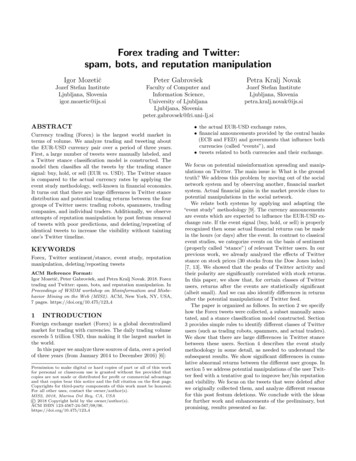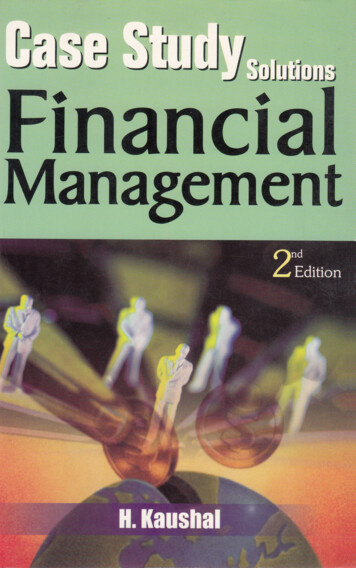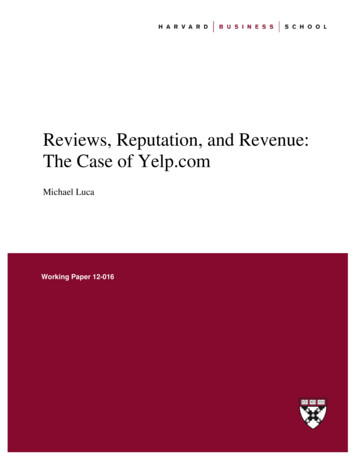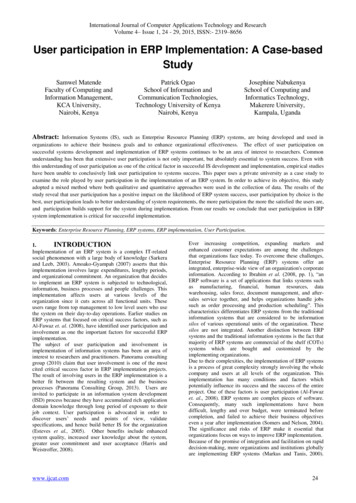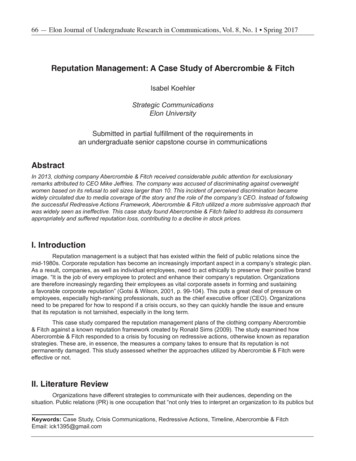
Transcription
66 — Elon Journal of Undergraduate Research in Communications, Vol. 8, No. 1 Spring 2017Reputation Management: A Case Study of Abercrombie & FitchIsabel KoehlerStrategic CommunicationsElon UniversitySubmitted in partial fulfillment of the requirements inan undergraduate senior capstone course in communicationsAbstractIn 2013, clothing company Abercrombie & Fitch received considerable public attention for exclusionaryremarks attributed to CEO Mike Jeffries. The company was accused of discriminating against overweightwomen based on its refusal to sell sizes larger than 10. This incident of perceived discrimination becamewidely circulated due to media coverage of the story and the role of the company’s CEO. Instead of followingthe successful Redressive Actions Framework, Abercrombie & Fitch utilized a more submissive approach thatwas widely seen as ineffective. This case study found Abercrombie & Fitch failed to address its consumersappropriately and suffered reputation loss, contributing to a decline in stock prices.I. IntroductionReputation management is a subject that has existed within the field of public relations since themid-1980s. Corporate reputation has become an increasingly important aspect in a company’s strategic plan.As a result, companies, as well as individual employees, need to act ethically to preserve their positive brandimage. “It is the job of every employee to protect and enhance their company’s reputation. Organizationsare therefore increasingly regarding their employees as vital corporate assets in forming and sustaininga favorable corporate reputation” (Gotsi & Wilson, 2001, p. 99-104). This puts a great deal of pressure onemployees, especially high-ranking professionals, such as the chief executive officer (CEO). Organizationsneed to be prepared for how to respond if a crisis occurs, so they can quickly handle the issue and ensurethat its reputation is not tarnished, especially in the long term.This case study compared the reputation management plans of the clothing company Abercrombie& Fitch against a known reputation framework created by Ronald Sims (2009). The study examined howAbercrombie & Fitch responded to a crisis by focusing on redressive actions, otherwise known as reparationstrategies. These are, in essence, the measures a company takes to ensure that its reputation is notpermanently damaged. This study assessed whether the approaches utilized by Abercrombie & Fitch wereeffective or not.II. Literature ReviewOrganizations have different strategies to communicate with their audiences, depending on thesituation. Public relations (PR) is one occupation that “not only tries to interpret an organization to its publics butKeywords: Case Study, Crisis Communications, Redressive Actions, Timeline, Abercrombie & FitchEmail: ick1395@gmail.com
Reputation Management: A Case Study of Abercrombie & Fitch by Isabel Koehler — 67also the public mind to the organization concerned” (Kaul, 1968, p. M-61). This two-way communication allowsfor direct engagement between the company and the public, which benefits the company in a variety of ways.After receiving feedback, organizations are able to address concerns that the public may have, as well as usethat input to make necessary improvements. To adequately tackle these responsibilities, PR divides its broaddomain into multiple categories, one of which is reputation management, which includes crisis communications.This field focuses on the “issue of rebuilding an organization’s reputation following an ethical scandal” (Sims,2009, p. 453).A strong reputation is vital in business, especially when it can lead to greater successes in the form ofmore revenue, respect, and attention. Brown (2010) stated, “It is a form of social capital that now appears onbalance sheets as a tangible asset, on CVs and resumes as references, and on websites and sales brochuresas customer testimonials” (p.56-64). Nonetheless, companies frequently make mistakes that can significantlydamage the way they are perceived, leading to long-term consequences, such as negative public opinion andfinancial loss. To avoid this pitfall, companies hire experts and form teams whose purpose is to respond toscandals and begin the recovery process.According to a study conducted by Davies and Miles (1998), “Reputation was presented to respondentsas having three facets: personality (what the organization really is), identity (what it says it is) and image (whatpeople see it as)” (p.18). Image can be used interchangeably with reputation itself when Sims (2009) stated,“Reputation is formed by the beliefs that people hold about an organization based upon their experience with it,their relationship to it, and their knowledge gained through word of mouth or mass media” (p. 454). Therefore,an organization must protect its reputation by remaining ethical in the eyes of its audience. This proves to bea challenge for companies as stakeholders’ concerns can change drastically over time “as do the norms andvalues of society” (Holden, Adnan, Browne, & Wilhelmij, 2001, p. 20). What’s considered acceptable at onepoint can be seen as outrageous after a few years. Unfortunately, entire companies are unable to modify theirmission as quickly as people transform their views. Although organizations may initially experience backlashdue to a damaged reputation, they can return to the public’s good graces by creating an effective response. Infact, “how corporations and their leaders respond after a scandal occurs is particularly important in determininghow long-lasting and pervasive the impact of a scandal will be on a firm’s reputation” (Sims, 2009, p. 455).Over the years scholars have created numerous frameworks for management professionals to followafter a crisis, one of which is known as “Redressive Actions.” Scholar Victor Turner defined this term as an“action that is intended to limit the breach and its impact of the crisis with ‘certain adjustive and redressivemechanisms” (Sims, 2009, p. 456).In order to make a lasting repair on a company’s reputation, there are a few general steps to follow.Organizations need to carefully choose the language in which they communicate and ensure that rebuildingplans are in place before the damage is permanent. These strategies can vary; however, more recently,organizations have decided to use social media as a platform for reparation and communication. This is adeliberate move by the institutions, which consider that a large percentage of the audience is involved insome form of social channel. “It is no longer a matter of whether a company should utilize social media tocommunicate with audiences, but rather how and with what platforms” (Walaski, 2013, p. 40). There are threecore principles to consider when maintaining a successful social media presence during a time of crisis: themessage, the channel, and the frequency. When discussing the message, it is important to remember that itis not just the words that matter, but also that the content is conveyed to the targeted audiences. This requiresorganizations to be aware of what channels their audience use most. In order to be informed, the managementteam should conduct research prior to their predicament, and they should already have a social media platformin place. In other words, “effective use requires advance planning, a targeted approach and a bit of legwork”(Walaski, 2013, p.44). Further proof of this can be illustrated when looking at an organization’s credibility. Acompany should regularly cultivate communication with its audiences to earn trust before any ethical concernsare raised. “Trust and credibility can be established through pre-crisis audience identification, identifying theplatforms they are using and engaging in those platforms to build relationships and rapport” (Walaski, 2013,p. 45). The longer an organization networks with its publics, the better it understands whom it is reaching. Thechannels a company uses to send the message through can also play a large role in fixing a calamity. Brandsoften have a sizable following of loyal customers that frequent different channels. Since organizations oftenhave extensive knowledge of their audiences, it will be easy for them to determine what messages should besent to which channels. “Different audiences have different expectations in terms of content and frequency. If
68 — Elon Journal of Undergraduate Research in Communications, Vol. 8, No. 1 Spring 2017an organization understands these expectations in advance and is prepared to meet them, it will be better ableto reinforce a positive reputation” (Walaski, 2013, p. 45). Facebook is a common networking site that will bediscussed further in regards to how Abercrombie & Fitch utilized this medium.Facebook, Instagram, and Twitter consistently serve as the three most popular social media platforms;each medium engages the audience in differing ways. While most media utilize visual and written forms ofcommunication, Facebook is unique in that it also uses sharing and interactive communication. This distinctivequality ensures that Facebook dominates other platforms. The original purpose of these channels altered astheir followers increased. In the past, these forums were used to sell products; however, currently, consumerslook to such sites for the majority of their information. Therefore, any negative comment or photo posted onthese channels about a product or service can reach millions of people and affect their opinions, thus socialmedia can clearly play a large role in a company’s reputation.The specific focus on reputation framework in this study includes leadership and redressive action.This is important for the purpose of this paper because leadership played a role in the negative public opinionof Abercrombie & Fitch. The first step involves how a leader reacts to a crisis internally. This can often meaneliminating members of the team who do not align with the company’s core values. When a company’s ethicalbehavior is brought into question, leaders have the opportunity to clarify the organization’s internally andexternally values. The second step to tackle a reputation crisis is to directly engage and address the issue. Thiscan be accomplished by crafting new policies, thus preventing the same problem from reoccurring. Thirdly,organizations should look toward role modeling as a way to improve reputation. Employees and the public alikelook at how managers deal with unethical behavior. If they simply talk about fixing the problem, but never act onthe issue, workers are likely to follow this lead, and the organization will continue to be portrayed in a negativelight. The next step in mending an institutions character is the allocation of rewards. Sims (2009) explained,“To ensure that new or specific values are accepted post-ethical scandals an organization’s redressive actionsmust reward behavior that is consistent with these values” (p. 461). Essentially, a company needs to habituallyreward good behavior and penalize poor behavior. Finally, a powerful way to rebuild a reputation is by selectingnew members to lead the organization in a positive direction. These five criteria are long-term solutionsproposed to appease the public and reinstate a positive image of the company. Analysis of Abercrombie & Fitchshowed whether it utilized this model, and if not, how it went about fixing its image.BackgroundAbercrombie & Fitch has been a well-known retail-clothing store for more than a century. However,since its inception in 1892, the brand image has changed drastically. Under the direction of David T.Abercrombie, the company was widely recognized as a store for hunting and fishing equipment. Throughthe 1960s, the company was largely successful. Unfortunately, its success did not last and the company wasforced to file for bankruptcy, leaving it open for new management. In 1988, Limited Brands Inc. took over andhired new CEO Mike Jeffries. Under his leadership, the merchandise became preppy and the brand finallyfound a niche. Jeffries ensured that the company remained on-trend, constantly updating its merchandiseto fit customers wants. According to a survey, “In the early 2000’s Abercrombie & Fitch was voted the sixthmost popular brand by teenagers” (Lepore, 2011). Now Abercrombie & Fitch is considered to be a high qualityAll-American clothing store that targets teenagers. Over the past several years, customers’ perception of thecompany has changed. What was once viewed as a popular clothing chain is now stale and notorious formultiple scandals; the most significant being its refusal to sell clothing for large women.As Abercrombie & Fitch’s publicity grew, the company began to experience more lawsuits. In 2004,negative attention was drawn to the company for its discriminatory hiring practices. The store was accused ofemploying sorority and fraternity type men and women, even if other applicants of various backgrounds werejust as, if not more, qualified. This subject was broached again when a Muslim woman, Hani Khan, accusedAbercrombie & Fitch of firing her based on physical appearance. Khan allegedly “had been allowed to weara hijab that matched the company’s colors until a district manager visited the store in February 2010 and sawher for the first time in a hijab. Khan was fired soon after” (“Abercrombie & Fitch pays,” 2013). This case wasresolved with compensatory charges as well as a policy change that allowed employees to wear religiousgarments.The example above is only one of the many that portrays the company’s obsession with superficialfactors, such as what employees are wearing. As the pressure to maintain their popular status amongst
Reputation Management: A Case Study of Abercrombie & Fitch by Isabel Koehler — 69customers increased, so did the company’s desire to stay “cool.” As a result, the company practiced manyexclusionary policies, apparently believing that hiring only attractive workers would draw attractive clientele.Jeffries stated, “That’s why we hire good-looking people in our stores. Because good-looking people attractother good-looking people, and we want to market to cool, good-looking people. We don’t market to anyoneother than that” (Schlossberg, 2016). This strategy may have worked at one point; however, people’s opinionshave changed. Thus in 2013, when a previous interview with Jeffries hosted by SALON.com was leaked, thebrand’s customers were not as forgiving. The details of this meeting were brought to the public eye after ABCpublished a story stating that the company did not make large sizes for women. Jeffries’ comments infuriatedthe public and led to a large crisis where the company’s reputation was brought into question.The study asked one research question: Was Abercrombie & Fitch effective in reputationmanagement based on Sims’ Redressive Actions framework?III. MethodsThis study examined a timeline that illustrates how Abercrombie & Fitch responded to a crisis thatnegatively affected its reputation.The timeline, as shown in Figure 1, portrays all the key events that occurred within the period of ayear. The top portion indicates how the press reacted to the scandal, while the bottom one reveals how thecompany replied to the audience, and in turn the crisis. This juxtaposition demonstrates the direct relationshipbetween press coverage and company responses. An organization’s reputation is extremely important toensure financial success. Media sources can greatly affect the public opinion; therefore, if coverage continuesto be negative, it may make recovery harder. With this in mind, it might be expected that Abercrombie & Fitchshould react in a way that will produce positive feedback and satisfy the public.Figure 1. Timeline illustrating how Abercrombie & Fitch responded to a crisis
70 — Elon Journal of Undergraduate Research in Communications, Vol. 8, No. 1 Spring 2017This paper examined whether Abercrombie & Fitch utilized an effective reputation management planby comparing it with the Redressive Actions framework outlined by Sims (2009). The five concepts within thisframework include the company and leader reacting to the crisis, engaging in the crisis, setting a tone for thecrisis, rewarding affirmative behavior demonstrated after the crisis, and replacing key players involved in thecrisis. Throughout history various companies have followed these criteria and consequently mended theirreputation. This study operationalized these concepts as follows: Leadership reaction: eliminate members for value differencesEngagement: address issues with actionSetting a tone: maintain model teams that act exemplaryReward allocations: reward model behavior and punish bad behaviorReplacement of key players: select newcomers to influence the organizationThis paper is a qualitative discussion of an organizational crisis through the lens of reputationmanagement.IV. FindingsIn Figure 1, the events of this crisis are grouped and divided into four separate stages: introduction,consumer response, company action, and resolution. The various colors in Figure 1 displays the associationbetween the events and the stages.Introduction to crisisThe first point in the timeline describes how the scandal was initially exposed to the public by presscoverage. On May 3, 2013, Business Insider reporter Ashley Lutz published a story that shed light on thefact that the company does not sell women’s clothes in sizes XL or XXL because “they don’t want overweightwomen wearing their brand” (Lutz, 2013). Lutz also uncovered details from a 2006 interview where Jeffriesmade similar remarks about exclusionary practices.In every school there are the cool and popular kids, and then there are the not-so-coolkids . . . candidly, we go after the cool kids. We go after the attractive all-American kidwith a great attitude and a lot of friends. A lot of people don’t belong [in our clothes], andthey can’t belong. Are we exclusionary? Absolutely. (Lutz, 2013)These comments from Jeffries and the lack of large sizes caused an outrage among the public andmarked the beginning of the crisis. Originally, Abercrombie & Fitch chose to respond to these verbal assaultsby using the corporate silence approach. This entails that the company “aimed at avoiding organizational‘ownership’ of the reputational threats” by not making any comments (Heugens, van Riel, & van den Bosch,2004, p.1373). Although, to outsiders, this tactic may be construed as avoidance, it is actually a well thoughtout plan that attempts to prevent association between a crisis and an organization. Other organizations, suchas Chipotle, have successfully implemented corporate silence, claiming that it did not want to comment ona well-publicized health scandal until every detail was confirmed. Because Abercrombie & Fitch is a clothingcompany, its silence cannot be explained away as easily; the published comments do not need furtherverification.Consumer ResponseThe public largely perceived Abercrombie & Fitch’s silence as lack of caring and persisted inprotesting. The second grouping, consumer response, gives two examples of how the public reacted tothe scandal, and in turn, how the company replied to the public. Some accused Abercrombie & Fitch ofintentionally leaving out certain segments of the population. This incident blew up into a widely known
Reputation Management: A Case Study of Abercrombie & Fitch by Isabel Koehler — 71scandal. Some observers began putting together protests and petitions to illustrate how this brand wasaffecting teens. On May 9, 2013, 18-year-old Benjamin O’Keefe created a petition on change.org that calledfor a boycott of the company until Jeffries apologized and sold larger sizes. His petition obtained almost80,000 signatures, by strategically using emotion to induce action. On May 19, 2013, Jeffries responded andposted an apology on Facebook.Figure 2. Mike Jeffries’ response to a crisisThis apology was one attempt at reputation management. To further spread the word, the companyput a link to this comment on Twitter. With a perceived lack of sincerity behind the words, some did not takeJeffries’ excuse to heart, and continued to lash out on Facebook. Multiple followers acted in disbelief; VickyAshton and Alexander G. Souther were only two of the many to post comebacks. Throughout this timenearly a million people posted on Facebook and Twitter noting their concerns, not including the many articlespublished in Business Insider, The Huffington Post, and Forbes. The scandal took on a life of its own andcaused Abercrombie & Fitch’s stock price to decline. According to its website, the stock share dropped from 58 to 26 after the six-month crisis period.Figure 3. Consumers’ Facebook rebuttals
72 — Elon Journal of Undergraduate Research in Communications, Vol. 8, No. 1 Spring 2017Less than a month later, the company published an anti-bullying press release that mirrored theirprevious sentiments and demonstrated the direction they planned to take moving forward (Abercrombie &Fitch, 2013b). Despite these explanations, no action was taken to reprimand the company or Jeffries.Company ActionThe third classification, company action, illustrates the dissatisfaction in press reports withAbercrombie & Fitch’s “actions,” and calls for actual steps to be taken in order to resolve the issue. Thefrustration with Abercrombie culminates into various articles, including Jillian Berman’s from The HuffingtonPost titled “Abercrombie Anti-Bullying Campaign Met with Surprise, Criticism from Protestors.” In response tothe press release, Berman (2013) issued the following:“It will take more than just an anti-bullying campaign to change his [Benjamin O’Keefe]mind about the company; he’d like to see a public commitment from Abercrombie tostock larger sizes for women as well as to include plus-sized models in its advertising.”It wasn’t until about a half year later that Abercrombie & Fitch finally mobilized, releasingrecommendations that they would sell larger sizes.ResolutionThe fourth category, resolution, shows press coverage that urges Jeffries to resign, and the finalefforts from the company to rectify the situation. Bloomberg published an article containing information fromEngaged Capital, a hedge fund that owns a share in Abercrombie & Fitch, pressing Jeffries to leave thecompany. There may be multiple reasons behind this action; however, the decline in stock prices caused byJeffries’ comments certainly factored into this decision. Abercrombie & Fitch responded to this demand by firstissuing a press release on about Jeffries’ new contract where he was not only paid less, but also stripped histitle as chairman (Abercrombie & Fitch, 2013a). His departure did not come until a year later on December 9,2014, when he retired. These enactments happened months after the scandal leaked, and therefore playedno part in calming the public backlash.V. DiscussionThrough the analysis of the four stages of introduction, consumer response, company action, andresolution above, it seems that the company responded only when necessary to stem the heated coverage.When looking at this in comparison with the redressive framework, the initial company actions were notnearly substantial enough to lessen the public furor, therefore putting the brand’s reputation on the line. Theredressive framework suggests actions that came later could have been more timely. The first frameworkcriterion, leadership reaction, emphasizes ridding the organization of team members whose values do not lineup with those of the company. Abercrombie failed to take this step, and kept Jeffries and his team on board,illustrating a lack of awareness for the comments he made and the resulting negative publicity.The second criterion, engagement, explains how a company should address the issue head on andcreate new policies that will tackle whatever problem occurred. According to the framework, Abercrombiechose the wrong course of action by withholding a response for a period of two weeks and failing toimplement any tangible plan. Initially, the company refused to respond to any negative comments by usingcorporate silence. Eventually, when Abercrombie finally did counter, the two press releases posted were noteffective. The first notice came in the form of a Facebook post. Despite the company’s knowledge of bothits target audience and most frequented channel, the apology lacked emotion, appearing to be formal andrehearsed. Forbes contributor Davia Temin said, “(Abercrombie) takes no responsibility for the action thatprompted the apology. It has no sense of mea culpa, or remorse, but rather seems to transfer the blameto you” (Temin, 2013). In fact, Abercrombie may have exacerbated the situation by publishing on a popularforum where anyone has the opportunity to comment. The second type of communication was in the formof a press release. This anti-bullying statement was not as widely circulated because it was advertised onAbercrombie’s website. Moreover, it indirectly confronted the situation. In order to truly help their reputation,
Reputation Management: A Case Study of Abercrombie & Fitch by Isabel Koehler — 73Abercrombie needed to take direct action by adding new plus-sized merchandise, instead of simply publishingwhat was perceived by some as disingenuous messages. Temin (2013) emphasizes, “The company couldhave put a wooden stake into the heart of the crisis – by not only issuing a resonant, authentic, heartfeltapology, but by taking some serious remedial actions, as well.” Although they ultimately did instate largersizes, it did not occur until November, when the situation was not at the forefront of consumers’ minds.The third criterion, setting a tone for the crisis, has to do with role models. Employees within acompany often act as exemplary figures to the public as well as mentors to new employees. This redressiveaction can then be described as showing how such employees should act as moral compasses to theiraudiences. If they are seen as corrupt, the new workers will follow their lead and the public will continue tolabel the brand negatively. In the case of Abercrombie & Fitch, the employees and leadership barely reactedto the scandal, therefore inadvertently downplaying the crisis, passively agreeing with the merchandise aswell as the previously stated comments. Had Abercrombie punished certain employees and made necessaryemployment adjustments, the public would have looked at the company in a better light.The fourth criterion, reward allocations, states that after an ethical scandal, organizations shouldreward moral behavior and punish immoral behavior. This not only demonstrates that the company knows thedifference between right and wrong, but also proves that they want to uphold certain standards. This researchsuggests that Abercrombie & Fitch may not have conformed to this criterion even after all the negative brandattention. As a result, Abercrombie’s total return to shareholders was far behind its peers (Berfield & Rupp,2015). If the company had immediately addressed this criterion, the public would potentially taken this actionas an indication of responsibility and the public may have been more accepting toward the clothing brand.The fifth and final criterion, replacement of key players, clarifies that selecting newcomers to anorganization is a powerful way for a leader to rebuild a company’s reputation. Abercrombie did not searchfor new employees right after the crisis escalated, and instead waited for almost a year to oust Jeffries aschairman and CEO. New appointees significantly strengthened the senior leadership team and planned tosteer the focus of the company toward its relationship with its customers. When looking at each of thesecriteria, it appears that Abercrombie & Fitch did not follow these guidelines.VI. ConclusionAn examination of the timeline demonstrates that the reputation management plans of Abercrombie& Fitch could have been more successful. The company’s meager reactions within the first several weeks ofthe crisis barely mentioned the real issue of providing larger sizes for its plus-sized market. The messagesthey published came in two forms: a Facebook post and press release. Neither evoked emotion from readers,but may have fueled their resentment against a company and leader who refused to take responsibility.Instead of attempting to appease the press and public via these forms of communication, Abercrombie &Fitch could have taken a more drastic step, and actually made policy changes. By the time the companyrealized this fact, it was way too late and the public had already established their opinions about the brand.When comparing Abercrombie’s methods with the Redressive Action framework, it may be concluded thatthe short-term solutions the company used were not as effective as they may have been. Had they appliedthe five redressive criteria, the actual company culture may have changed, potentially attracting old and newcustomers.The impact on Abercrombie & Fitch can be seen in its financial records in 2013. Months after theBusiness Insider article was published, which gained a considerable amount of negative attention, the stockportfolio showed an increase in sales but a decrease in stock price. Essentially, one of the company’s mainsource of financial support, the investors, decided to withdraw and withhold donations. Overall this causeda loss of income (“Morning Document Research,” 2009). Although the decline is most likely a direct resultof the statements by the company, there could also be some other factors, including trouble with staying onthe fashion trend of the time. Although this framework provides strategies that are proven to be successfulat this point, other structures may become more relevant as our corporate environments continue to changewith time. Even since 2013, the Internet has grown drastically, lending to new forms of interaction. Currently,people can re
Jun 07, 2017 · Reputation Management: A Case Study of Abercrombie & Fitch by Isabel Koehler — 67 also the public mind to the organization concerned” (Kaul, 1968, p. M-61). This two-way communication allows for direct engagement between the company and the

